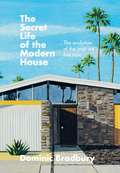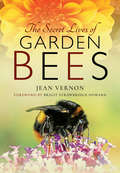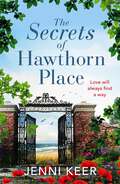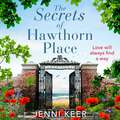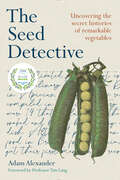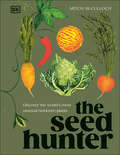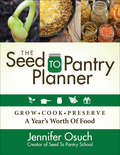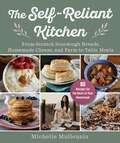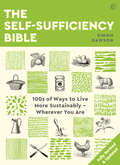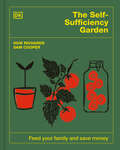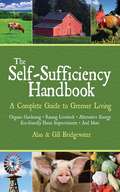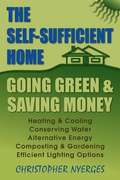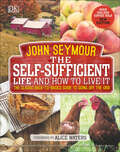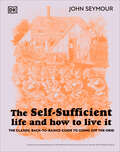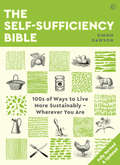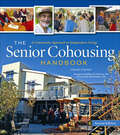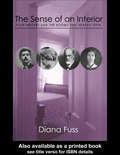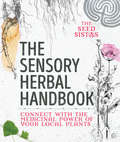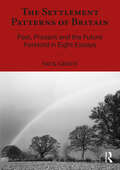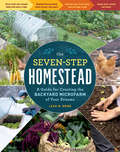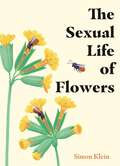- Table View
- List View
The Secret Life of the Modern House: The Evolution of the Way We Live Now
by Dominic BradburyOver the last century the way that we live at home has changed dramatically. Nothing short of a design revolution has transformed our houses and the spaces within them - moving from traditional patterns of living all the way through to an era of more fluid, open-plan and modern styles. Whether we live in a new home or a period house, our spaces will have been shaped one way or another by the pioneering Modernists and Mid-century architects and designers who argued for a fresh way of life. Architectural and design writer Dominic Bradbury charts the course of this voyage all the way from the late 19th century through to the houses of today in this ground-breaking book. Over nineteen thematic chapters, he explains the way our houses have been reinvented, while taking in - along the way - the giants of Art Deco, influential Modernists including Le Corbusier and Frank Lloyd Wright, as well as post-war innovators such as Eero Saarinen and Philip Johnson. Taking us from the 20th to the 21st century, Bradbury explores the progress of 'modernity' itself and reveals the secret history of our very own homes.
The Secret Lives of Garden Bees
by Jean VernonA friendly, accessible guide into the weird, but wonderful world of bees in the gardens of the UK.From the common or garden bumblebees that nest in bird boxes, compost heaps, and old mouse holes making “Winnie the Pooh” style honey pots to feed their babes; to the quirky wool carder bee, a solitary bee that combs the fluff from garden plants to line her brood cells; and the amazing leaf cutter bee that carves chunks out of plant foliage to seal its egg chambers . . .This book will reveal the secrets and fascinating lives of the bees that live and breed in your garden, from buzz pollination, to the bee robbers that cheat the plants and steal nectar by stealth.With a chapter per season to explore what you are likely to see in your garden, great plants to grow to help them, plus other fascinating information on these secretive creatures, this book is designed to bring alive the world of garden before your very eyes.“The colorful narrative radiates the authors love for bees and is punctuated with heaps of beautiful photographs. Easily read from cover to cover or dipped in to when in need of bee identification.” —Sunday Express (UK)
The Secrets of Hawthorn Place: A heartfelt and charming dual-time story of the power of love
by Jenni Keer'This is definitely up there as one of the best books that I have read. It's got a special place in my heart. Just amazing!' 5* reader reviewLove will always find a way . . . Discover the intriguing secrets of Hawthorn Place in this heartfelt dual-time novel, filled with warmth and charm, perfect for fans of Lucinda Riley and Cecelia Ahern.'An exquisitely detailed and enchanting love story' HEIDI SWAIN'An epic love story, mixed with gorgeous settings, a great deal of mystery and intrigue, lots of laughs, a few tears and fabulous characters, made this an absolute delight to read' KIM NASH'An absolutely wonderful dual time story that captivated me . . . and kept me spellbound' CHRISTINA COURTENAY'A beautifully intriguing love story, that . . . stays with you long after the last page' ROSIE HENDRY'Unforgettable and unique, the twists and turns of this enchanting book are woven together with threads of love and magic. I loved it!' CLARE MARCHANT........................................................................Two houses, hundreds of miles apart . . . yet connected always.When life throws Molly Butterfield a curveball, she decides to spend some time with her recently widowed granddad, Wally, at Hawthorn Place, his quirky Victorian house on the Dorset coast. But cosseted Molly struggles to look after herself, never mind her grieving granddad, until the accidental discovery of an identical Arts and Crafts house on the Norfolk coast offers her an unexpected purpose, as well as revealing a bewildering mystery. Discovering that both Hawthorn Place and Acacia House were designed by architect Percy Gladwell, Molly uncovers the secret of a love which linked them, so powerful it defied reason. What follows is a summer which will change Molly for ever . . .........................................................................'One of those wonderful, magical stories that appear rarely and stay in your heart forever' CELIA ANDERSON'A marvellous dual-time novel filled with mystery, fabulous detail and an enduring love story' MADDIE PLEASE'A wonderful, page-turning story full of intrigue and romance' VICTORIA CONNELLY'I found the book enchanting' SUZANNE SNOW'An enchanting storyline and engaging characters make this book a delight to read' LYNNE SHELBY'A beautifully written timeslip . . . Highly recommended. Five stars' ERIN GREEN'The perfect mix of mystery, magic, and romance' KATE G. SMITHEarly readers are captivated by The Secrets of Hawthorn Place:'A sweeping five stars from me for this novel that defies time but trusts in love''A sheer delight to read and can highly recommend''Utterly brilliant. The storyline is riveting, you never quite know what could be about to happen as it's constantly twisting and turning . . . such a beautiful book'
The Secrets of Hawthorn Place: A heartfelt and charming dual-time story of the power of love
by Jenni Keer'This is definitely up there as one of the best books that I have read. It's got a special place in my heart. Just amazing!' 5* reader review'Gorgeous! Exuberant writing, convincing, adorable characters, romance and a little whimsy' TRACY REESLove will always find a way . . . Discover the intriguing secrets of Hawthorn Place in this heartfelt dual-time novel, filled with warmth and charm, perfect for fans of Lucinda Riley and Cecelia Ahern.'An intriguing dual timeline tale that weaves together interesting characters and history, with an added touch of magic' BELLA OSBORNE'An exquisitely detailed and enchanting love story' HEIDI SWAIN'An epic love story, mixed with gorgeous settings, a great deal of mystery and intrigue, lots of laughs, a few tears and fabulous characters, made this an absolute delight to read' KIM NASH'An absolutely wonderful dual time story that captivated me . . . and kept me spellbound' CHRISTINA COURTENAY'A beautifully intriguing love story, that . . . stays with you long after the last page' ROSIE HENDRY'Unforgettable and unique, the twists and turns of this enchanting book are woven together with threads of love and magic. I loved it!' CLARE MARCHANT........................................................................Two houses, hundreds of miles apart . . . yet connected always.When life throws Molly Butterfield a curveball, she decides to spend some time with her recently widowed granddad, Wally, at Hawthorn Place, his quirky Victorian house on the Dorset coast. But cosseted Molly struggles to look after herself, never mind her grieving granddad, until the accidental discovery of an identical Arts and Crafts house on the Norfolk coast offers her an unexpected purpose, as well as revealing a bewildering mystery. Discovering that both Hawthorn Place and Acacia House were designed by architect Percy Gladwell, Molly uncovers the secret of a love which linked them, so powerful it defied reason. What follows is a summer which will change Molly for ever . . .........................................................................'One of those wonderful, magical stories that appear rarely and stay in your heart forever' CELIA ANDERSON'A marvellous dual-time novel filled with mystery, fabulous detail and an enduring love story' MADDIE PLEASE'A wonderful, page-turning story full of intrigue and romance' VICTORIA CONNELLY'I found the book enchanting' SUZANNE SNOW'An enchanting storyline and engaging characters make this book a delight to read' LYNNE SHELBY'A beautifully written timeslip . . . Highly recommended. Five stars' ERIN GREEN'The perfect mix of mystery, magic, and romance' KATE G. SMITHEarly readers are captivated by The Secrets of Hawthorn Place:'A sweeping five stars from me for this novel that defies time but trusts in love''A sheer delight to read and can highly recommend''Utterly brilliant. The storyline is riveting, you never quite know what could be about to happen as it's constantly twisting and turning . . . such a beautiful book'
The Secrets of Hawthorn Place: A heartfelt and charming dual-time story of the power of love
by Jenni KeerLove will always find a way . . . Discover the intriguing secrets of Hawthorn Place in this heartfelt dual-time novel, filled with warmth and charm, perfect for fans of Lucinda Riley and Cecelia Ahern.'An exquisitely detailed and enchanting love story' HEIDI SWAIN'Unforgettable and unique, the twists and turns of this enchanting book are woven together with threads of love and magic. I loved it!' CLARE MARCHANT........................................................................Two houses, hundreds of miles apart . . . yet connected always.When life throws Molly Butterfield a curveball, she decides to spend some time with her recently widowed granddad, Wally, at Hawthorn Place, his quirky Victorian house on the Dorset coast. But cosseted Molly struggles to look after herself, never mind her grieving granddad, until the accidental discovery of an identical Arts and Crafts house on the Norfolk coast offers her an unexpected purpose, as well as revealing a bewildering mystery. Discovering that both Hawthorn Place and Acacia House were designed by architect Percy Gladwell, Molly uncovers the secret of a love which linked them, so powerful it defied reason. What follows is a summer which will change Molly for ever . . .........................................................................'One of those wonderful, magical stories that appear rarely and stay in your heart forever' CELIA ANDERSON'A marvellous dual-time novel filled with mystery, fabulous detail and an enduring love story' MADDIE PLEASE'I found the book enchanting' SUZANNE SNOW(P) 2021 Headline Publishing Group Ltd
The Seed Detective: Uncovering the Secret Histories of Remarkable Vegetables
by Adam Alexander‘Informative, enlightening and entertaining but also important.’ Mark Diacono ‘One of the most inspirational books I have encountered.’ Darina Allen ‘If you’re a vegetable growing addict or just curious about their origins, there’s something for everyone in Adam’s new book.’ Rob Smith, TV presenter 'The writing is rich . . . [This book] is a clarion call to think about our food in new ways and carefully consider where it comes from.' New Scientist Meet the Indiana Jones of vegetables on his quest to save our heritage produce. Have you ever wondered how everyday staples such as peas, kale, asparagus, beans, squash and sweetcorn ended up on our plates? Well, so did Adam Alexander. Adam’s passion for heritage vegetables was ignited when he tasted an unusual, sweet and fiery pepper while on a filmmaking project in Ukraine. Smitten by its flavour, he began to seek out local growers of old and near-forgotten varieties in a mission to bring home seeds to grow and share – saving them from being lost forever. In The Seed Detective, Adam tells of his far flung (and closer to home) seed-hunting adventures and reveals the stories behind many of our everyday vegetable heroes. How the common garden pea was domesticated from three wild species over 8,500 years ago, that the first carrots originated in Afghanistan (and were actually purple or red in colour), how Egyptian priests considered it a crime to look at a fava bean and that the Romans were fanatical about asparagus. Join The Seed Detective as he takes us on a journey that began when we left the life of hunter-gatherers to become farmers. Sharing storiesof globalisation, political intrigue, colonisation and serendipity, Adam shows us the vital part vegetables have played in our food story – and how they are the key to our future.
The Seed Detective: Uncovering the Secret Histories of Remarkable Vegetables
by Adam AlexanderMeet the Indiana Jones of vegetables and join him on his quest to save our heritage produce.Named BBC Radio 4's The Food Programme "Book of the Year"2023 GardenComm Media Awards Silver Laurel Medal of AchievementShortlisted for the Garden Media Guild&’s Garden Book of the Year Award 2023Longlisted for The Art of Eating Prize 2023"[This book] is a clarion call to think about our food in new ways and carefully consider where it comes from."—New ScientistDid you ever wonder how peas, kale, asparagus, beans, squash, and corn have ended up on our plates? Well, so did Adam Alexander.Adam Alexander is The Seed Detective. His passion for vegetables was ignited when he tasted an unusual sweet pepper with a fiery heart while on a filmmaking project in Ukraine. Smitten by its flavor, Adam began to seek out local growers of endangered heritage and heirloom varieties in a mission to bring home seeds to grow, share, and return so that he could enjoy their delicious taste—and save them from being lost forever.In The Seed Detective, Adam shares his own stories of seed hunting, with the origin stories behind many of our everyday food heroes. Taking us on a journey that began when we left the life of the hunter-gatherer to become farmers, he tells tales of globalization, political intrigue, colonization, and serendipity—describing how these vegetables and their travels have become embedded in our food cultures.&“We are a nation of vegetable growers and this book explores the wonderful world of rare and endangered heritage and heirloom vegetables – and why we must keep growing them and saving their seed, not only for our gardening and culinary pleasure, but to pass these stories on – vegetables are truly our history on a plate.&”—The Seed Detective"Copious but thoroughly engaging research . . . Alexander shares his excitement over the potential for rescuing this lost heritage. . . All of which makes this title worth a serious look."—Booklist (starred)"[The Seed Detective] traces the origins and evolution of vegetables that have shaped human civilization."—Atlas Obscura&“[A] spirited introduction to the contemporary seed-saving movement. . . . With entertaining anecdotes that feature Syrian fava beans, Ukrainian sweet peppers and broad beans from Myanmar, Alexander's horticultural adventures will surely stimulate and unleash readers' inner gardeners.&”—Shelf Awareness"For Adam Alexander seeds are more than just a job, hobby or passion. They&’re a lifeline."—Modern Farmer
The Seed Hunter: Discover the World's Most Unusual Heirloom Plants
by Mitch McCullochWhy grow the same dull vegetables and herbs that fill every grocery store shelf? If you're putting in the effort and growing your own, make it something sensational!There's a thrilling diversity of rare and unusual heirloom plants out there—a riot of beauty, color, and flavor that can only be experienced by growing your own. So saddle up and join the trail blazed by Mitch the Seed Hunter as he shows you how to source, grow, and enjoy the most amazing crops from around the world.The antithesis of mass-produced hybrids and genetically modified seeds, heirloom crops provide a connection to the past, seeds that have been passed down through generations, rescued from oblivion, and preserved by a dedicated community of growers.From Italian flat onions to pink broad beans, apple-sized melons beloved by Queen Anne to purple-and-white Gniff carrots from Switzerland (almost lost to extinction), and orange okra from Japan to ancient Aztec broccoli, Mitch shares his passion for growing them all and making the most of their incredible flavors.
The Seed to Pantry Planner: Grow, Cook, & Preserve A Year's Worth of Food
by Jennifer OsuchThe first ever guide that helps homesteaders and urban farmers alike feed their families for an entire year from a nutrient dense, fully stocked pantry.The Seed to Pantry Planner is a game changer. No more guessing how many tomato plants are needed to grow to feed a family. DIY farmers simply insert the number of people in their family and get the number of plants that they need to plant. The Seed to Pantry Planner is an actual yearly planner which helps to keep everything in one place, including month-at-a-glance pages for readers to record appointments along with birthdays and week-at-a-glance pages to record daily to-do lists. Within The Seed to Pantry Planner, there are: Charts for food preservation through home canningCharts for food preservation through home dehydratingGenerous worksheet spaceRecipe multiplier worksheetsWorksheets for prioritizing goalsGraphs for planning a gardenSeed starting calendarsWorksheets to keep track of herbs and roots used medicinallyMonthly budget planner worksheetsWeekly menu planning sheets that include planning for preserving
The Self-Reliant Kitchen: From-Scratch Sourdough Breads, Homemade Cheese, and Farm-to-Table Meals
by Michelle MullennixTraditional skills, heritage recipes, and food preparation techniques from the generations before us. If you're ready to stop relying on overly processed foods from the grocery store and start nourishing yourself and your family with healthier options, this book is for you. Through easy-to-follow recipes and traditional cooking skills, this cookbook inspires and empowers you to create a more self-reliant kitchen. Recipes include: Sourdough Cinnamon Raisin Bread Home-Churned Butter Raspberry Preserves Homemade Pasta Chicken Pot Pie Sourdough Fried Chicken Pot Roast Nourishing Bone Broth Homemade Pickles Healthy Grape Gummies Homemade Maple Vanilla Marshmallows And many more! Learn how to replace manufactured, over-processed store bought food items with delicious from-scratch dishes one recipe at a time!
The Self-Sufficiency Bible
by Simon DawsonPacked with practical information and expert advice on everything from gardening to cooking, and from health and beauty to raising livestock, this is the indispensable guide to self-sufficiency. Whether you live in a small flat in the city or have land of your own in the countryside, The Self-Sufficiency Bible encourages you to sit up and say, ?I can do that'!
The Self-Sufficiency Bible
by Simon DawsonPacked with practical information and expert advice on everything from gardening to cooking, and from health and beauty to raising livestock, this is the indispensable guide to self-sufficiency. Whether you live in a small flat in the city or have land of your own in the countryside, The Self-Sufficiency Bible encourages you to sit up and say, ?I can do that'!
The Self-Sufficiency Garden: Feed Your Family and Save Money: THE #1 SUNDAY TIMES BESTSELLER
by Huw Richards Sam CooperEat homegrown food all year round and save money on your weekly shop by following a simple plan for self-sufficiency.Huw Richards and Sam Cooper have spent the past two years planning and trialing their self-sufficiency garden in a 10x13m plot, and now they've worked out the perfect formula. Grow six portions of nutritious veg a day per person following their month-by-month growing plan, which is realistic and flexible with cost, space, and time in mind. Follow this carefully curated year-round growing plan to yield six portions of veg per person per day, plus batching and preserving recipes! Whether you are looking for cost-effective ways to put food on the table and feed your family, a fan of Huw’s YouTube videos and would like to try out the recipes for yourself or a gardener who would like some guidance on how to grow your own food, this book will be great for you.With this gardening book, you will be able to:-Learn about Huw's self-sufficiency ethos, goals, and approaches to growing food-Create your garden and learn how to build all the growing spaces you will need, such as hotbeds and polytunnels-Follow month-by-month planting plans with guidance on key tasks throughout the year and different seasons-Perfect your growing skills with sowing, weeding, watering, and composting.-Discover useful kitchen tips for meal prep, storage, and preserving ideas along with base recipes so you can make the most of your crops. -Find recipes for delicious dishes including soup, curry, tray bakes and salads + dressingsFollow Huw Richards and SamCooper’s tried-and-tested methods and save money while enjoying homegrown food all year. If you are interested in learning more or want more books by Huw Richards, check out these titles: Veg in One Bed, Grow Food For Free, and The Vegetable Grower's Handbook.
The Self-Sufficiency Handbook: A Complete Guide to Greener Living (Handbook Series)
by Gill Bridgewater Alan BridgewaterAnyone considering a shift to a greener way of living must get this inspirational and practical guide. With easy-to-read layouts and simple text, it runs the full ecological gamut, from geothermal heating to crop rotation to soap making. The Bridgewaters, well-regarded garden writers, help readers answer questions such as how much land they really require, whether or not to depend entirely on natural forms of energy, and which farm animals will best meet their needs. There's practical information on building an insulated flue-pipe chimney, identifying edible wild plants, and composting with worms. In addition to recipes for jams, rhubarb wine, and other delicious foods, three A-Z sections offer planting and harvesting instructions for vegetables and salad crops, fruits, and herbs.
The Self-Sufficient Home: Going Green and Saving Money
by Christopher NyergesHow to cut heating and cooling costs, utilize solar energy, construct nonflush toilets and solar showers, collect rainwater, and apply permaculture techniques. The author explains everything in plain, easily understood, language with hundreds of photographs and diagrams that illustrate ways to use natural resources and embrace self-reliance. Sustainable living advice from self-reliance expert Christopher Nyerges, editor of "Wilderness Way" magazine and author of "How to Survive Anywhere."In an ever-changing economy, cutting costs and utilizing available resources is essential. From embracing solar energy and wind power to using fluorescent bulbs and growing backyard vegetable gardens, there are endless ways to live a more ecological and economical lifestyle. The book offers a collection of testimonials and hordes of practical information on living lightly on the planet.
The Self-Sufficient Life and How to Live It: Comp Back-to-Basics Guide US AKG 20
by John SeymourEmbrace off-grid green living with the bestselling classic guide to a more sustainable way of life from the father of self-sufficiency. For over 40 years, John Seymour has inspired thousands to make more responsible, enriching, and eco-friendly choices with his advice on living sustainably. The Self-Sufficient Life & How To Live It offers step-by-step instructions on everything from chopping trees to harnessing solar power; from growing fruit and vegetables, and preserving and pickling your harvest, to baking bread, brewing beer, and making cheese. Seymour shows you how to live off the land, running your own smallholding or homestead, keeping chickens, and raising livestock. Featured in pages of this off-grid guide, you will find: - Detailed advice for achieving a self-sufficient lifestyle no matter your outdoor space, including guides for getting the most from urban gardens, allotments, and larger holdings.- Encyclopaedic knowledge on cultivating fruits and vegetables, rearing and preparing livestock, foraging, brewing, and home crafts like woodwork and pottery. - Beautiful illustrated galleries of fruit and vegetables to inspire growers. - Charming original hand-drawn illustrations accompany step-by-step guides to dozens of home crafts and self-sufficiency skills, including storing crops, saddling horses, butchering a pig, making wine, and making a footstool. - A new foreword from a high-profile current follower and advocate of his message.In a world of mass production, intensive farming, and food miles, Seymour&’s words offer an alternative: a celebration of the joy of investing time, labor, and love into the things we need. While we can&’t all be able to move to the countryside, we can appreciate the need to eat food that has been grown ethically or create things we can cherish, using skills that have been handed down through generations. With refreshed, retro-style illustrations and timeless advice reviewed to reflect the latest organic gardening guidelines, this new edition of Seymour&’s classic title is a balm for anyone who has ever sought solace away from the madness of modern life.
The Self-Sufficient Life and How to Live It: The Complete Back-to-Basics Guide
by John SeymourThe Self Sufficient Life and How to Live It is the only book that teaches all the skills needed to live independently in harmony with the land harnessing natural forms of energy, raising crops and keeping livestock, preserving foodstuffs, making beer and wine, basketry, carpentry, weaving, and much more. Our 2003 edition included 150 new full-color illustrations and a special section in which John Seymour, the father of the back to basics movement, explains the philosophy of self-sufficiency and its power to transform lives and create communities. More relevant than ever in our high-tech world, The Self Sufficient Life and How to Live It is the ultimate practical guide for realists and dreamers alike.
The Self-sufficiency Bible: 100s of Ways to Live More Sustainably Wherever You Are
by Simon DawsonA fully revised and updated edition of the self-sufficiency classic. Packed with practical information and expert advice on everything from gardening to cooking, and from health and beauty to raising livestock, this is the indispensable guide to living more sustainably, whether you live in a city apartment block or on a rural smallholding."A treasure-trove of brilliant ideas and easy-to-follow step-by-step instructions" - Adam Henson, BBC One's CountryfileIn our current era of pandemic and environmental crisis, self-sufficiency is a means of taking control of our lives and safeguarding for the future - and this new, fully updated edition of the sustainability classic will help every householder do just that. You'll find all the practical information and expert guidance you need on every aspect of self-sufficiency, from gardening and baking through health, beauty and cleaning to foraging and livestock, whatever your needs, circumstances and resources. This means that the gardening chapter, for example, is appropriate both for people with an urban back yard or a more substantial plot of land. Written in a down-to-earth, engaging and often amusing style, and charmingly illustrated with line drawings, the book will appeal to anyone who wants to be more creative, resourceful and independent, who wants to rediscover their inner hunter-gatherer, to single people as much as to large families, and to parents looking to equip their children with basic life skills.
The Senior Cohousing Handbook: A Community Approach to Independent Living
by Charles DurrettHow to make your senior years healthy, safe, social, and stimulating. "Architect and author Chuck Durrett's recently released book Senior Cohousing Handbook comes at a time of high interest in greening, sustainable housing and affordable living concerns. Durrett's new book is a comprehensive guide for baby boomers wishing to continue vibrant, active lifestyles." - EPR Real Estate News"Make your senior years safe and socially fun with the idea of senior cohousing and a book on the topic that shows how seniors can custom-build their neighborhood to fit their needs. This is housing built by seniors, not for them, and emphasizes independence and social networking. Any library strong in gerontology or social science and many a general lending library needs this. - James A. Cox, The Midwest Book Review"As a Baby Boomer, I've joked for a few years that we'll all end up living communally again because Social Security will be broke...This is one of the better ways to envision it."-- Sacramento Bee No matter how rich life is in youth and middle age, the elder years can bring on increasing isolation and loneliness as social connections lessen, especially if friends and family members move away.Senior cohousing fills a niche for this demographic—the healthy, educated, and proactive adults who want to live in a social and environmentally vibrant community. These seniors are already wanting to ward off the aging process, so they are unlikely to want to live in assisted housing. Senior cohousing revolves around custom-built neighborhoods organized by the seniors themselves in order to fit in with their real needs, wants, and aspirations for health, longevity, and quality of life. Senior Cohousing is a comprehensive guide to joining or creating a cohousing project, written by the US leader in the field. The author deals with all the psychological and logistical aspects of senior cohousing and addresses common concerns, fears, and misunderstandings. He emphasizes the many positive benefits of cohousing, including:Better physical, mental, emotional, and spiritual healthFriendships and accessible social contactSafety and securityAffordabilityShared resourcesSuccessful aging requires control of one’s life, and today's generation of seniors—the baby boomers—will find that this book holds a compelling vision for their future.Charles Durrett is a principal at McCamant & Durrett in Nevada City, California, a firm that specializes in affordable cohousing. He co-authored the groundbreaking Cohousing with his wife and business partner, Kathryn McCamant.
The Sense of an Interior: Four Rooms and the Writers that Shaped Them
by Diana FussThe Sense of an Interior is a fascinating exploration of domestic space and of the ways it determines how writers work. The book looks at four famous figures - Emily Dickinson, Sigmund Freud, Helen Keller, and Marcel Proust, and examines the relationship between their work and the spaces where they wrote.
The Sensory Herbal Handbook: Connect with the Medicinal Power of Your Local Plants
by Bruce Parry Fiona Heckels Karen Lawton Belle BenfieldThe charismatic Seed Sistas distill over 20 years of clinical and teaching experience into an easy-to-use comprehensive system of herbal medicine. This book empowers readers to take charge of their own wellbeing by reconnecting them with their local plants, and with the land, the elements and the seasons."A unique mix of knowledge and wisdom, respect and irreverence" - Bruce ParryThis book has been written for anyone who has heard the whispers of the wild and has been stirred to know more, for those with a political conscience and for lovers of the outdoors. Whether you are new to the ways of herbs or already a practising herbalist, it explains how you can take your physical and mental health into your own hands using the plants that grow around you.Sensory Herbalism is a unique system of health devised by the Seed Sistas over 20 years of practice. It combines traditional herbal knowledge with an understanding of how the elements (water, fire, air, earth and spirit) and the ever-changing seasons interact with the human body. Their approach blends science, medicine, creativity, ritual, magic and fun into practical, easy-to-use tools that guide readers in developing their own relationship with plants. Illustrated with 140 artworks, photographs and diagrams, the book offers a revolutionary understanding of how to get to know and use your local medicinal plants. Understand plants better than ever before using the five tools of Sensory Herbalism: observation through the senses, intuition, interpretation, characterization and the poetic creation of plant dreams. Embark on a guided journey through the year, deepening your knowledge of each season's featured plants and enhancing your wellbeing with herbal medicines, nutritious recipes and healing rituals.
The Settlement Patterns of Britain: Past, Present and the Future Foretold in Eight Essays (Planning, History and Environment Series)
by Nick GreenIn writing The Settlement Patterns of Britain Nick Green was inspired by the short story genre. His book is a collection of eight non-fiction short stories or essays, where the characters are the places, some of which appear more than once, usually as bit-part players, occasionally as the main protagonist. Preceded by a prologue describing Britain’s prehistory as a European peninsula, each essay covers a fixed period in the history of the development of Britain’s settlement patterns, sometimes long, more often quite short, beginning around 2,500 BC and ending about one hundred years in the future. Nick Green chose those periods that are particularly instructive in revealing how settlement patterns come to exist in the form they do and how they might develop in the future. Settlement patterns are not just about where a place is, but about how that place relates to others. They wax and wane with circumstance, and around each settlement’s fixed core, the patterns of living and working shift constantly, driven by forces beyond the control of any individual town or city or village. From Bronze Age communities to computer simulations, from the mediaeval wool trade to the hyper-networked society, from Viking invasions to the post-industrial era, the essays cover a broad sweep of history. They appear in chronological order, but are not intended to provide a continuous, linear historical narrative – nor do they: each essay is freestanding so they can be read in whatever order the reader prefers.
The Seven-Step Homestead: A Guide for Creating the Backyard Microfarm of Your Dreams
by Leah M. WebbFor the burgeoning number of backyard gardeners aspiring to grow a rich array of fresh food for their families, The Seven-Step Homestead offers a doable, incremental program for turning any yard into a primary food source with vegetables, fruits, chickens, pollinator plants, and medicinal herbs over the course of several years.
The Sexual Life of Flowers
by Simon Klein'A fascinating treasure trove for plant lovers and gardeners alike.' - Frances TophillOften beautiful and sometimes strange, flowering plants have evolved to become masters of seduction.We are surrounded by extraordinary partnerships between plants and the birds, bees and other insects that pollinate them. In The Sexual Life of Flowers, botanist Simon Klein leads a beguiling and fascinating tour of the courtship between fifty flowers and the pollinators vital to their survival.From the siren scent of honeysuckle to the radiating warmth of the sunflower or the ultraviolet signal of the red poppy; tales of botanical charm, deception and intrigue are played out amid an annual explosion of activity in gardens, meadows and woodlands. Lavishly illustrated in full colour, this is a beautiful collection for gardeners and anyone with an interest in flowers.
The Sexual Life of Flowers
by Simon Klein'A fascinating treasure trove for plant lovers and gardeners alike.' - Frances TophillOften beautiful and sometimes strange, flowering plants have evolved to become masters of seduction.We are surrounded by extraordinary partnerships between plants and the birds, bees and other insects that pollinate them. In The Sexual Life of Flowers, botanist Simon Klein leads a beguiling and fascinating tour of the courtship between fifty flowers and the pollinators vital to their survival.From the siren scent of honeysuckle to the radiating warmth of the sunflower or the ultraviolet signal of the red poppy; tales of botanical charm, deception and intrigue are played out amid an annual explosion of activity in gardens, meadows and woodlands. Lavishly illustrated in full colour, this is a beautiful collection for gardeners and anyone with an interest in flowers.
